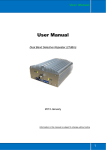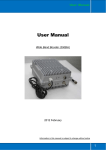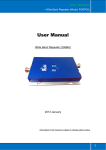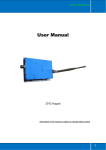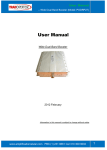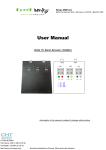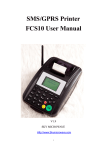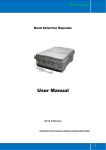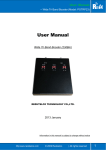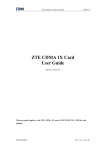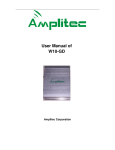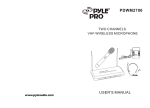Download User Manual
Transcript
User Manual User Manual Wide Dual Band Repeater (20dBm) 2014 January Information in this manual is subject to change without notice 1 User Manual Table of Contents 1 Description ................................................................................................. 3 2 Technical Specifications............................................................................. 4 3 System Diagram ........................................................................................ 4 4 Product Features ....................................................................................... 3 5 Applications Example ................................................................................ 5 6 5.1 Minimum Signal Levels .................................................................... 6 5.2 Custom Applications ......................................................................... 6 5.3 Isolation and Separation................................................................... 7 Production Operation ................................................................................. 7 6.1 Notices ............................................................................................. 7 6.2 Installation ........................................................................................ 8 6.3 Commissioning ................................................................................. 9 NOTICE: SWITCH AC POWER OFF BEFORE DONOR AND SERVICE ANTENNA CONNECTS TO REPEATER. 2 User Manual 1 Description is a bi-directional amplifier used to enhance signals between a mobile and a base station. This repeater type is used for digital telecommunication system: 1) -It picks up the strongest signal from BTS via the Donor Antenna, 2) -Linearly amplifies the signal and then retransmits it via the Indoor Signal Distribution System to the weak/blind coverage area. 3) -And the mobile signal is also amplified and retransmitted to the BTS via the opposite direction. It features with customized frequency band, flexible installation, cost-effectiveness and ideal coverage solution, its output power varies from 20dBm to 23dBm. It is applied to small, medium-size areas such as home, offices, shops, and basements, remote countryside , and mining well etc. This model booster is commonly used in situations where large numbers of frequency carriers are to be repeated or when base station synthesized frequency hopping is used. 2 Product Features High system gain>65dB, High system output power>20dBm Light weight, small dimensions, easy to install Smart Automatic Level Control (ALC) to reduce interference to BTS Linear power amplification to effectively suppress inter-modulation and spurious emission An alarm interface with unique color LEDs to indicate power supply and signal level of uplink and downlink Simple installation with external AC/DC adapter Dual ports and full duplex design 3 User Manual 3 Technical Specifications Band A Band B 824~849MHz 1850~1910MHz 869~894MHZ 1930~1990MHZ Uplink 65±2dB 65±2dB Downlink 65±2dB 65±2dB Uplink 20±2dBm 20±2dBm Downlink 20±2dBm 20±2dBm Network(Customized) Gain Output Power Gain Adjust Scope MGC≥30 Gain Adjust Step 1dB Gain Adjust precision 0~10dB/±1dB#10~20dB/±1.5dB#20~31dB/±2dB Band Ripple ±4 ALC Scope 20dB Frequency Error ≤±0.05 I/O Impedance 50Ω/N connector VSWR ≤1.5 Noise figure ≤8 Spurious Emission ≤-36dBm@9KHz~1GHz/≤-30dBm@1~12.75GHz IM3 -40dBc Delay ≤0.5μs Max Input Power Level(1minute) -10dBm RF Connector N-Type (Female) Temperature Range Operation: -25°C ~ + 55°C;Storage: -30°C ~ +60°C Relative humidity 5~95% RH Power consumption 50W Power Supply AC220V Power Supply(Customized) 100~240VAC Dimension (mm) 160×100×30mm Weight(kg) 1.0kg Indicator PWR LED Light @ Power supply on ALM LED Light @ system work wrong or isolation problem Bar LED Signal strength indicator 4 System Diagram The RF link (donor) towards the base station is typically fed from an outdoor antenna while the coverage area is fed by an indoor antenna 4 User Manual The RF link (donor) towards the base station is typically fed from an outdoor antenna while the coverage area is fed by an indoor antenna or connected to mobile antenna directly. The signal from the base station is received via directly antenna, then forwarded through a duplex filter, is amplified in a low noise amplifier (LNA), enters the RF filter for wideband selective, and then amplified in the power amplifier. The output signal passes a duplex filter, before it is fed to mobile or indoor antenna which retransmits the signal to the aim areas. 5 Applications Example 5 5.1 User Manual Minimum Signal Levels It requires a minimum signal level in the place where install the donor antenna. Failure to provide sufficient input signal will only result in a poor coverage inside the building for this repeater system. To check signal levels, use the phones in the place where antenna be install (on the roof) and observe the signal bars on the phone. The Donor (outside) antenna should be placed in the location where you get the most signal. Notices: 1) The donor antenna should have line of sight (LOS) with the BTS antenna. If the signal strength is adequate, LOS may in some cases not be necessary. 2) Donor antenna gains are typically 9 to 14 dB, and have a horizontal and vertical beam width of less than 30° to correctly select the donor BTS. 5.2 Custom Applications If building is made of concrete, steel, steel roof, copper roof, brick, aluminum siding, concrete roofing tiles, metal roofing tiles or any other signal stopping material, a repeater is usually the ideal solution for your situation. Most homes or buildings are easily covered by one repeater systems. Some buildings are larger or have multiple areas inside that need coverage. 6 User Manual It may need longer cables, more than 2 coverage antennas or other items in order to fully cover your building. We can make (almost) any cable length and can help design a system that fits your application. 5.3 Isolation and Separation Isolation refers to the proper distance or separation needed to keep the Donor antenna signal pattern and the Coverage antenna signal pattern away from each other. Isolation becomes particularly problematic when Omni-directional antennas are used for both the Donor and the Coverage antennas. Since these antennas transmit in a circle (or more accurately a sphere) it is very easy for these spheres to overlap and thus negate the repeater system. 6 Production Operation 6.1 Notices Follow below safety items carefully before installation, implementation, maintenance and operation for this product ) BS and MS port must be connected to donor antenna and service antenna when powers supply on; otherwise the equipment will be damage for long term use. 7 User Manual ) When use repeater for outdoor, the distance between donor antenna and service antenna must be >20metes, otherwise the repeater will be damage because isolation problem for long term use. ) Donor antenna need to be lighting proof and lighting rod need to be install for donor antenna installation pole outside ) Check input power, require input power less than maximum input power of repeater, otherwise the repeater cannot work well. ) Keep clear for label and indicator on surface of repeater to be identified. 6.2 Installation Step 1: Start by taking phone up to the roof or other location outside to find where the signal is strongest. Step 2: Temporarily mount the Donor (outside) antenna in that location. It may need to adjust and move the antenna later. Step 3: Run coaxial cable into the building to a convenient location where you can also get standard 220VAC power for the repeater. Step 4: Place the repeater in that location and connect the coaxial cable to the Donor Side of the repeater and the donor antenna. Step 5: Mount coverage (inside) antenna in a productive location. It may need to adjust or move the antenna later. Step 6: Connect coaxial cable between the coverage antenna and the repeater output port. Step 7: Power up the system and check for signal inside the building. If needed, tune system by moving and or pointing the Donor and Coverage antennas until get the most signal possible. Step 8: Secure all antennas and cables, securely mount the repeater and clean up the installation. 8 6.3 User Manual Commissioning Item Description Usage BTS Connect to Donor antenna Receive BTS signal source MS Connect to Service antenna Retransmitted signal to target coverage area PWR Power Supply Indicator Show Power Supply Status ALM Repeater Working Status Show Repeater Working Status Bar Signal Strength Indicator Show Repeater output power strenght ) The repeater work in indoor, the indoor condition should meet environment requirement, such as temperature, waterproof, installation space and interference source ; ) In order to receive right BTS signal, the antenna be directly toward to visual BTS. ) RF connectors should be link tighten; ) Use mobile signal bars to check coverage effect on site. ) For dual band repeater, if one band signal is not well, you can change the donor antenna direction and check the change until it reach good coverage. ) For dual band repeater, the donor antenna direction must be adjustment angle by angle, so the dual band input power require good signal at the same time , then dual band repeater can work with maximum coverage area and distance. 9









